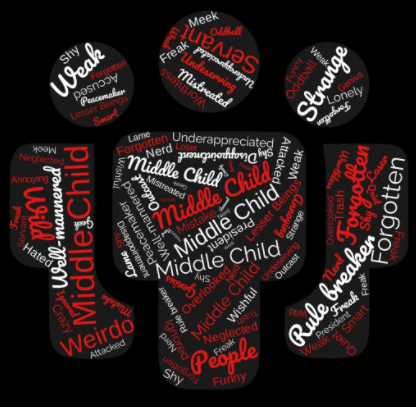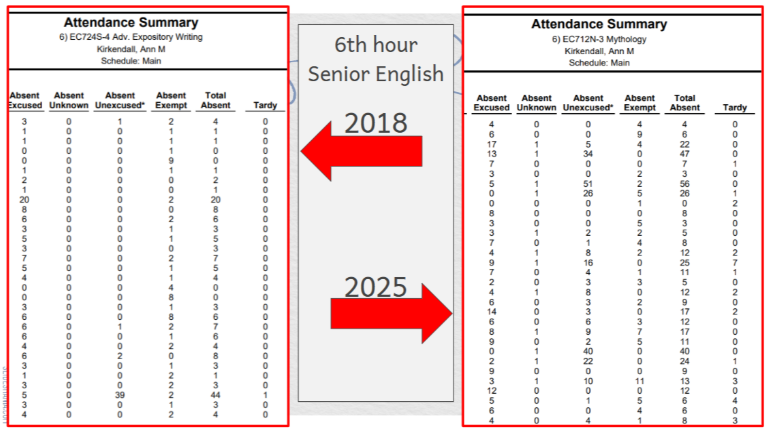Stuck in the middle: The realities of being a middle child

December 11, 2021
Trapped in between the oldest and the youngest, the middle child struggles to find their place in the family. A common consensus of birth order places the oldest child as the leader and the youngest as the adored baby, leaving the middle child with a complicated role in the family.
Chores
The role of a middle child entails that they must accept unpleasant tasks. Middle children must do more chores than the other siblings without getting any recognition for their time and dedication to the task.
“I help with chores a lot more than my siblings do. Growing up I saw my other siblings always get in trouble for not doing enough so I decided to be better,” Sr. Jessie Servis said.
Servis, a middle child, learned from her siblings the best way to avoid conflict was to be a more dedicated and obedient child. Doing work to avoid conflict easily becomes a habit that will become increasingly worthless in the eyes of the parents, leaving the middle child with heavier chore loads until they leave home.
The blame game
Middle children must also accept blame for the chaos and mess made by the other siblings. The other siblings can make any mess they want and toss blame onto the middle child. The younger siblings claim the middle child influenced them and encouraged the mess. The oldest child gains more trust from the parents because they’re older, making them more credible in the eyes of the parents.
Younger and older siblings know what cards to play when it comes to getting the middle child in trouble.
The older sibling whines and often plays the “comparative card.” The oldest sibling trudges up all that’s different between the middle child and themself. They often develop some claim along the lines of “but it’s hard being me,” then providing some limited one-time example of when they felt they were shortcut instead of the middle child. Or, they compare themselves in a way that demeans the middle child.
The youngest child uses the “fake cry card” far too often, but it works. The youngest is the forever “baby” of the home. They’re the last bird to leave the nest, so the parents must treasure their time with the last of their children. It’s in a youngest child’s nature to fake cry and make a scene over nothing, just to get the attention and sympathy of their parents.
The middle child by no means wants to let their siblings play their cards. This is when the middle child resigns their passive role to dispute their siblings’ motives and actions, which only gets the attention of their parents. Speaking out and standing up just to be shut down and forced to accept punishment for starting an argument while the oldest and youngest have miraculously evaded the punishment.
Peacemaking
Middle children are also tasked with the difficult role as the peacemaker in the family. The older and younger siblings bicker and engage in combat, physical and verbal, leaving the middle child to make peace between the two, which never goes well. Being the peacemaker only enrages the other siblings, turning them against the middle child, forming unity between the older and younger siblings, but exiling the middle child.
“I feel like I’m a mediator in my family, so like when there’s a problem, even now as adults, if there’s a problem in the family, my older brother and my younger brother will call me to help with the problem-solving. Even my mom, she’ll call me to help solve a problem with one of my siblings,” Shanna Meyer, an adult middle child, said.
A middle child’s work is never over. Even in the role of the great peacemaker, the middle child cannot escape the pains of their birth order, even into adulthood as Meyer has experienced. In order to be a peacemaker, a sacrifice is required, which is nothing new to the middle child.
Abraham Lincoln, the great emancipator, is regarded in history as a significant figure in peacemaking within the U.S. and one of the greatest presidents of all time. Lincoln’s skills in peacemaking might be supported by his birth order that places him as a middle child.
In fact, over the course of American history, 50% of the forty-six presidents we’ve had were middle children. These middle-children presidents, like Lincoln, were often known in history for their peacemaking significance that revolutionized the U.S.
Some of these other presidents include George Washington, Dwight D. Eisenhower, Theodore Roosevelt, and nineteen others that have all contributed to developing our nation.
Considering one major role as the middle child is being the peacemaker, some aren’t particularly surprised that 50% of U.S. presidents have been middle children. Middle children are also well equipped for the presidency given their communicative nature and conversational skills.
Humor
Middle children are now being stereotyped for their conversational humor, making them great candidates for public speaking. The type of humor usually pinned to middle children is the sarcastic humor, chaotic hilarity, and those terrible punny dad-jokes that everyone loves so much.
“I think I find myself being funny in a more sarcastic way when compared to my siblings. My sister likes to tell a lot of jokes using puns and stuff like that, but I use more dry humor,” Servis said. Servis notes her style of humor as a sarcastic tone, which seems to be the official language of middle children.
Meyer concurred with Servis saying that her own family was very sarcastic, especially her father who used sarcasm as his “love language.” Though Meyer considers herself to be a sarcastic person, she generalizes her joking style of a punny sort as well.
Even Frosh. Briana Wenger, a younger sibling, agreed that middle children tend to be more sarcastic, noting that around half of her friends are middle children that lean towards a sarcastic style of humor.
David Letterman is one of the most heavily regarded comedians and talk show hosts of all time, known for his witty and sarcastic humor. This great comic is a middle child, which isn’t a huge surprise, seeing as the middle child is short-changed, which only pushes the negative outlook and condescending and doubtful attitude people so frequently characterize and label as sarcastic humor.
Middle children according to psychology
Personality is largely affected by birth order. The personality of a middle child can be characterized easily in psychological terms.
Alfred Adler, an Austrian psychotherapist, developed the Middle Child Syndrome, placing birth order as a direct factor in the behavior that individuals carry on, specifically theorizing that middle children are stuck between the more obvious roles of oldest and youngest siblings, leaving middle children without any real role or importance in the family.
Middle Child Syndrome states that middle children will feel more neglected than any of the other siblings, leading them to stray from the idea of familial importance.
Middle Child Syndrome builds on the theory that middle children are more socially approachable and agreeable. Within the family, middle children develop the skill to mediate and become peacemakers in the family, giving them power in social conventions.
Middle Child Syndrome also theorizes that middle children are less likely to rebel and are more stable than their siblings.
“Being the middle child you are ignored most often,” Meyer said.
Meyer recalled the moment being a middle child defined her most. “For me personally it was basically when both of my brothers were misbehaving. My older brother and my younger brother were both in trouble for different reasons and it had been like a week-long battle with each of them. But I never got checked in with for basically an entire week because I wasn’t being a problem. I also was not really included during that time period,” Meyer said.
However, Meyer recognizes herself as “the most well-rounded” of her siblings. Meyer strongly believes that Middle Child Syndrome exists and even stands as an example to support aspects of being a middle child as theorized by Middle Child Syndrome.
The theory of Middle Child Syndrome formulates these key components of a middle child that have sparked interest in the entertainment industry. An apparent trend in television shows places middle children as the perfect recipe for a hilariously intriguing main character.
The presence of middle children in television has been prominent in creating hit shows led by the curious middle child. Television shows like Malcolm in the Middle and Stuck in the Middle were built around the unique middle child that stands out in the family for some kind of genius activity.
Middle children television characters have also been amongst the most favored characters on television such as Lisa Simpson in The Simpsons, the highly intelligent sibling destined for a great career of substantial importance.
Middle children have been characterized by society and pop culture through all these different stereotypes that label them with stark contrasts.
The biggest benefit
One of the biggest benefits of being a middle child is the learning experience they receive from their older siblings. “I find myself following in my older sister’s footsteps a lot. She was involved in a lot of stuff and encouraged me to do the same!” Servis said.
Meyer and Servis both acknowledged their gratitude for their siblings’ role in helping them navigate as they got older.
“I got to learn from the mistakes of my older brother and my younger brother along the way,” Meyer said.
Middle children face a lot of challenges with their birth order, yet they still manage to find the positives of being a middle child, such as the experience and assistance they gain from their siblings.
The stigma
As a youngest sibling, Wenger has acknowledged the treatment of her friends who are middle children, claiming that their birth order should not dictate their treatment by others or their quality of life. “Middle children shouldn’t have to demand attention from their family,” Wenger said.
Middle children are often negatively characterized by their family members, but really shine in several areas far more than their siblings despite the criticism and neglectful life they’ve been handed. Middle children are pinned with these exaggerated negative stereotypes, but their positive stereotypes never seem to reach far into the minds of the public.



